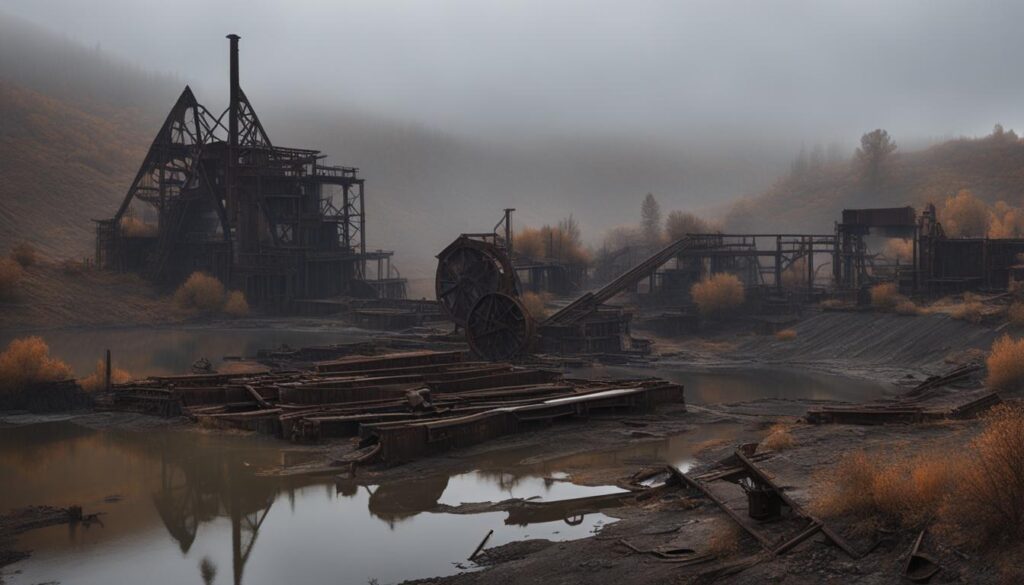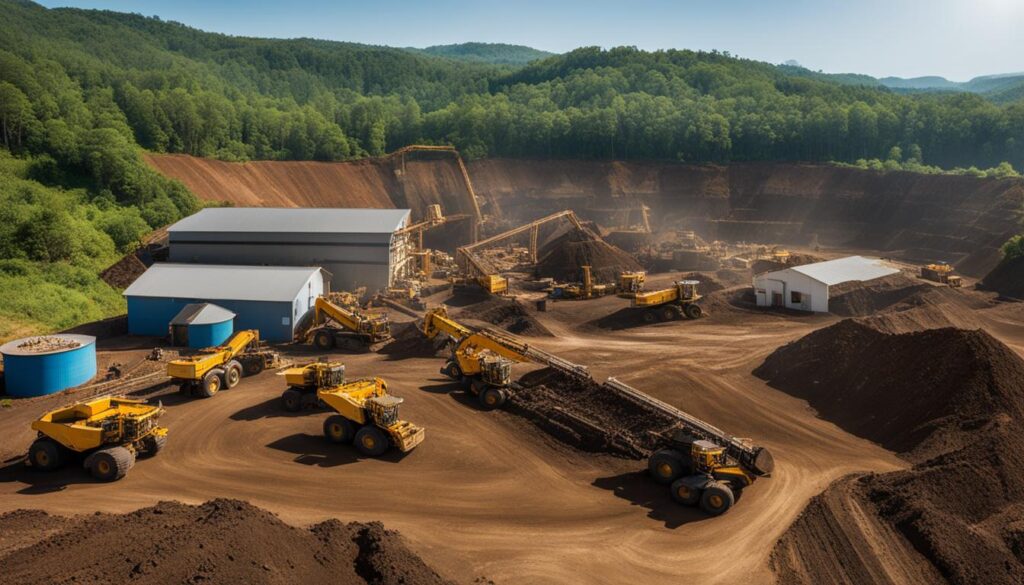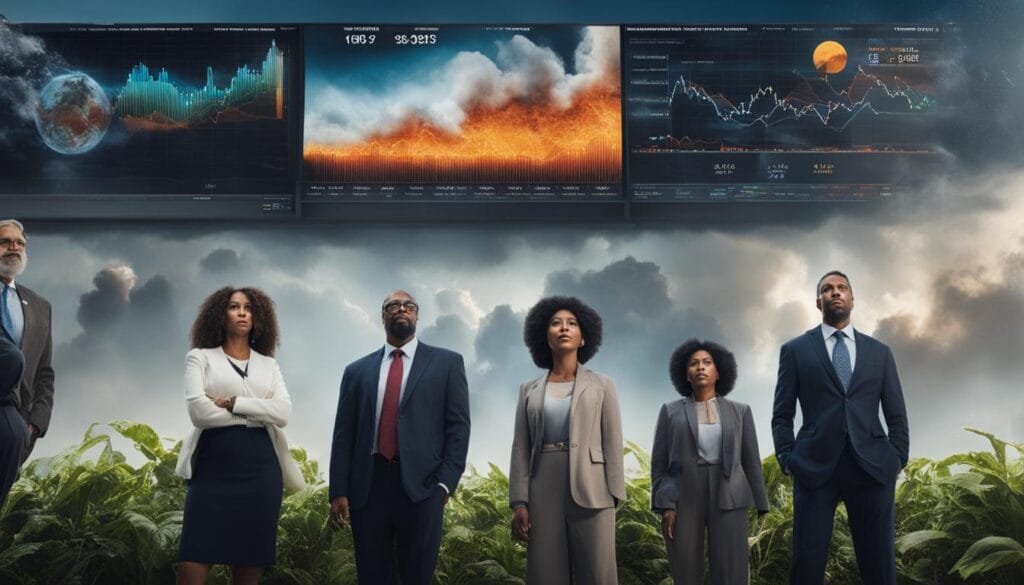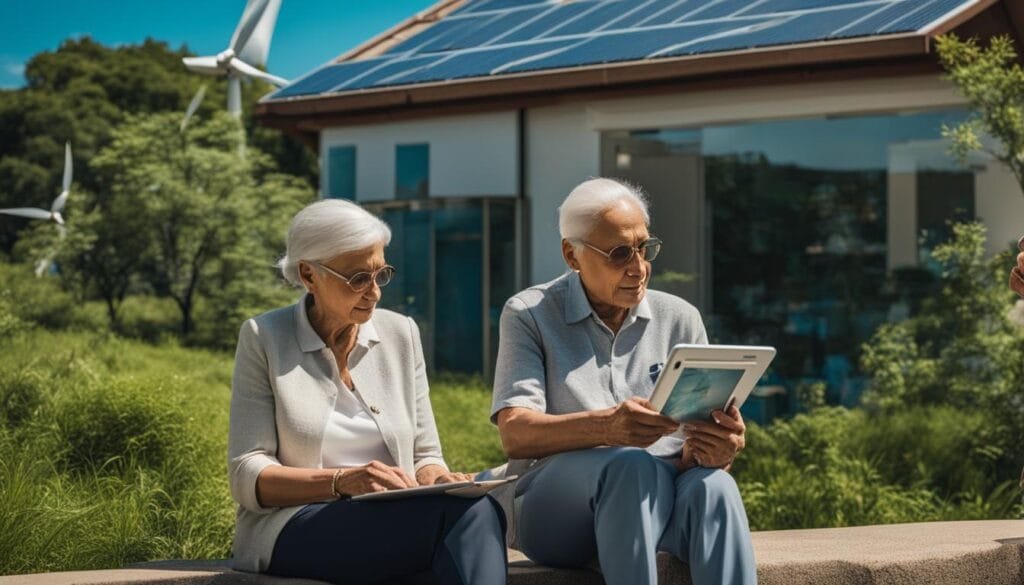Climate change is driving significant shifts in investment strategies, with a growing focus on green and climate-conscious opportunities. As the world strives for sustainability, investment decisions are being influenced by environmental, social, and governance (ESG) themes. One sector that has recognized the importance of these factors is the gold industry.
Historically, the gold industry has faced challenges, such as artisanal and small-scale mining (ASM) practices that contribute to environmental damage. However, companies are now actively working towards improving sustainability efforts, engaging in social responsibility, and investing in technological advances to reduce their impact on the environment.
Key Takeaways:
- Climate change is driving a shift towards climate-conscious investing.
- The gold industry is recognizing the importance of sustainability and ESG themes.
- Artisanal and small-scale mining (ASM) practices pose challenges to the industry.
- Improving sustainability efforts and investing in technology can reduce environmental impact.
- Investment opportunities exist in sectors focused on green and climate-conscious solutions.
Artisanal Mining: Challenges and Impacts
Artisanal and small-scale mining (ASM) is prevalent in many countries, with estimates of roughly 45 million people involved across 80 countries. ASM refers to mining operations that are often conducted illegally, without proper regulations or oversight. This form of mining poses a range of challenges and has significant impacts on the environment and local communities.
The increase in ASM production is driven by a higher gold price, population growth, lack of economic opportunities, and technological advancements. However, ASM operations use gravity separation, followed by chemical solutions with mercury or cyanide, resulting in severe environmental contamination. The improper handling and disposal of toxic substances contribute to soil and water pollution, harming ecosystems and endangering public health.
“Artisanal mining is a complex issue with far-reaching consequences. It not only affects the environment but also the social and economic fabric of communities,” says Dr. Emma Thompson, a leading expert in sustainable mining practices.
Furthermore, ASM operations often occur in remote and impoverished areas, where the lack of formal employment options drives individuals to engage in these activities. The unregulated nature of ASM leads to tax revenue losses, the facilitation of organized crime, and unsafe working conditions for miners. Despite these challenges, commercial gold mining companies, although separate from ASM operations, are increasingly working towards cleaning up environmental damage and providing legal employment opportunities for ASM miners.
Artisanal Mining: Environmental Damage
The environmental impact of artisanal mining is a cause for concern. The use of mercury and cyanide in gold extraction contaminates soil, water, and aquatic ecosystems, leading to the destruction of biodiversity. Additionally, the uncontrolled extraction of gold from rivers and streams disrupts natural habitats, causing erosion and sedimentation.
| Environmental Impact | Consequences |
|---|---|
| Water Pollution | Contaminated water sources, harming aquatic life and endangering human health. |
| Land Degradation | Deforestation, soil erosion, and loss of biodiversity due to informal mining practices. |
| Air Pollution | Release of toxic gases and dust particles during burning and processing of gold ores. |
Addressing these environmental concerns requires a multi-faceted approach that involves stricter regulations, improved monitoring, and sustainable mining practices. Collaborative efforts between governments, mining companies, and local communities are necessary to mitigate the negative impacts of artisanal mining and promote responsible mining practices.
The consequences of artisanal mining go beyond environmental damage. In the next section, we will delve into the efforts made by the mining industry to address these challenges and promote social responsibility.
Addressing Headline Disasters in Mining
Mining has faced headline disasters, such as the failure of a tailings dam in Brazil, resulting in significant loss of life and environmental damage. These incidents serve as a wake-up call to the mining industry, highlighting the need for stringent safety measures and proper tailings management. While mining carries inherent risks, it is important to note that there are thousands of properly designed and constructed tailings facilities worldwide.
Gold mines, in particular, have a lower risk of such disasters compared to other mining operations due to their smaller scale. However, mining companies across the industry are actively adopting safety measures and focusing on proper tailings management to minimize the risk of failures. The industry aims to learn from past disasters and prioritize the safety of employees and the environment.
To ensure the safety of tailings dams, mining companies are implementing various measures. These include regular inspections and monitoring, employing advanced technologies for dam stability assessment, and improving emergency response protocols. Additionally, there is an increasing emphasis on transparency and accountability in reporting safety measures and the status of tailings facilities.
Case Study: The Mariana Dam Disaster
“The Mariana dam disaster in Brazil was a devastating event that resulted in the loss of lives and widespread environmental damage. It highlighted the urgent need for the mining industry to address safety issues and improve practices. Since then, mining companies have been investing in advanced technologies, conducting regular dam inspections, and enhancing emergency response plans to minimize risks and protect communities and ecosystems. The lessons learned from such disasters have spurred a renewed commitment to safety in the industry.”
| Common Safety Measures | Benefits |
|---|---|
| Regular inspections and monitoring of tailings facilities | Early detection of potential issues and timely remediation |
| Advanced technologies for dam stability assessment | Accurate and detailed evaluation of dam integrity |
| Improved emergency response protocols | Efficient and effective handling of emergencies |
| Transparency and accountability in reporting | Builds trust with stakeholders and ensures compliance with safety standards |
By implementing these safety measures and prioritizing responsible mining practices, the industry is working towards minimizing the risk of headline disasters and ensuring the well-being of both workers and the environment. Ongoing advancements in technology and ongoing dialogue between stakeholders are crucial in this endeavor.

Overcoming Challenges of Historic Mining Practices

Historic mining practices have left a legacy of environmental damage and pollution in many areas. These abandoned pre-World War II mining sites are often portrayed by environmental extremists as the image of mining. However, the global regulatory framework now in place prevents the construction of operations that would cause such damage.
Mining companies understand the importance of environmental restoration and invest in various measures to address the challenges posed by historic mining practices. They dedicate resources to drilling, testing, engineering, and metallurgical work to develop comprehensive life-of-mine plans that include the reclamation of the landscape post-mining.
Examples of successful remediation projects exist, showcasing the industry’s commitment to environmental restoration. Through additional drilling and incorporation into development plans, these mining sites can be reclaimed and restored. By embracing these practices, the mining industry demonstrates its dedication to responsible resource use and environmental sustainability.
The Importance of Environmental Restoration
Environmental restoration is a vital aspect of overcoming the challenges posed by historic mining practices. It involves the assessment, planning, and implementation of actions to mitigate environmental damage and restore ecosystems. Mining companies understand their responsibility to restore the land they have impacted and work towards leaving a positive legacy for future generations.
| Benefits of Environmental Restoration in Mining | Examples of Successful Restoration Projects |
|---|---|
|
|
“Environmental restoration is not only a moral obligation but also a strategic investment in the long-term sustainability of the mining industry. By reclaiming and restoring historic mining sites, we contribute to the preservation of our environment and ensure a brighter future for local communities.”
Mining companies continue to prioritize environmental restoration as part of their mining operations. By working closely with regulators, local communities, and environmental experts, they strive to minimize the impact of historic mining practices and create a more sustainable future.
The Positive Impact of Mining: Social Responsibility
Mining companies play a crucial role in the communities and countries where they operate, making positive impacts through various initiatives. One key aspect of their contribution is the creation of employment opportunities. By providing jobs, mining companies improve livelihoods, stimulate economic growth, and uplift local communities. These employment opportunities not only benefit individuals and their families but also have a ripple effect on the broader community by boosting local businesses and supporting other sectors.
Furthermore, mining companies invest in infrastructure improvements that benefit both the local communities and the environment. They often collaborate with local authorities to build roads, schools, hospitals, and other essential facilities that enhance the overall quality of life. These infrastructure projects not only create immediate economic value but also leave a lasting legacy for the community long after the mining operations have ceased.
In addition to employment and infrastructure, mining companies prioritize the health and education of the communities they operate in. They implement programs to improve access to healthcare services, promote disease prevention, and support education initiatives. By investing in these areas, mining companies contribute to the overall well-being and development of the communities, leaving a positive and lasting impact.

| Benefits | Examples |
|---|---|
| Employment Opportunities | Creation of jobs for local residents |
| Infrastructure Improvements | Construction of schools, hospitals, and roads |
| Health and Education | Investment in healthcare services and educational programs |
Improving ESG Reporting in the Mining Industry
The mining industry is recognizing the importance of environmental, social, and governance (ESG) reporting and is making strides towards greater transparency and accountability. Historically, mining companies struggled with poor reporting on their ESG activities, but this is changing as the industry acknowledges the need to address sustainability challenges.
Companies are now dedicating sections of their websites to sustainability efforts, providing detailed information on their environmental impact, community engagement initiatives, and governance practices. This increased transparency allows investors to make more informed decisions and encourages companies to prioritize their ESG performance.
“ESG reporting plays a crucial role in building trust and credibility for mining companies,” says ESG analyst Jane Smith. “Investors are increasingly looking for companies that demonstrate a commitment to sustainability and responsible resource use.”
In addition to improved reporting, mining companies are actively working towards reducing their carbon footprint. With the global push for net-zero emissions, the industry is implementing strategies to manage emissions and exploring renewable energy sources. While greenhouse gas (GHG) emissions pose a significant challenge for mining companies, the industry is committed to meeting these goals and contributing to a sustainable future.
The Importance of ESG Reporting
- Enhances transparency and accountability.
- Builds trust and credibility with stakeholders.
- Helps investors make informed decisions.
- Drives companies to improve sustainability efforts.
- Contributes to a greener, more responsible mining industry.
Key Focus Areas for ESG Reporting
| Environmental | Social | Governance |
|---|---|---|
| Carbon emissions | Community engagement | Board diversity |
| Water management | Health and safety | Executive compensation |
| Biodiversity protection | Employee relations | Anti-corruption measures |
Improving ESG reporting in the mining industry is a crucial step towards a more sustainable future. By providing clear and comprehensive information on their ESG performance, mining companies can demonstrate their commitment to responsible resource use and contribute to the global green revolution.
The Rise of Coconut Coir Bulk: A Sustainable Material
Coconut coir bulk products have emerged as a versatile and renewable resource with various applications. Derived from coconut husks, which were traditionally considered waste, coconut coir is now used in gardening, agriculture, erosion control, and even construction. It offers benefits such as excellent water retention, aeration, and pH neutrality in gardening. Coir blankets and mats stabilize soil and reduce erosion. In construction, coir-based materials provide insulation, sustainability, and durability. Coconut coir is renewable, biodegradable, reduces chemical usage, and contributes to carbon sequestration, making it a sustainable choice.
| Uses of Coconut Coir Bulk | Benefits |
|---|---|
| Gardening |
|
| Erosion control |
|
| Construction |
|
Coconut coir bulk products offer an eco-friendly alternative to conventional materials. They can replace non-renewable resources and reduce the environmental impact of various industries. By utilizing coconut coir, businesses and individuals contribute to sustainability efforts and help create a greener future.
“Coconut coir is a game-changer in sustainable materials. It offers excellent performance in gardening, erosion control, and construction, while also being renewable and biodegradable. It’s a win-win for both the environment and the industries that embrace it.”
The Environmental Benefits of Coconut Coir Bulk
Coconut coir bulk products have several environmental benefits that make them an ideal choice for sustainable material solutions:
- Renewable: Coconut coir is derived from coconut husks, a byproduct of the coconut industry. By utilizing this waste material, coconut coir reduces the demand for non-renewable resources.
- Biodegradable: Coconut coir naturally decomposes over time, minimizing waste and environmental pollution.
- Reduced chemical usage: Coconut coir requires fewer chemical additives compared to other materials, reducing the release of harmful substances into the environment.
- Carbon sequestration: Coconut coir contributes to carbon sequestration, removing carbon dioxide from the atmosphere and helping mitigate climate change.
The rise of coconut coir bulk products highlights the growing importance of sustainable and eco-friendly materials in various industries. By opting for coconut coir, businesses and individuals can play a part in preserving the environment for future generations.
Conclusion
As we strive for a sustainable future, the green revolution presents immense opportunities for investment and responsible resource use. With climate change becoming an increasingly urgent concern, investing in sectors that focus on environmental solutions and sustainability is not only financially rewarding but also crucial for the well-being of our planet.
Mining companies have recognized the challenges they face and are actively working towards improving their sustainability efforts. By adopting safety measures, proper tailings management, and investing in technological advancements, the industry is prioritizing the safety of employees and the environment. These actions not only minimize the risk of disasters but also contribute to the responsible extraction of valuable resources.
Coconut coir bulk products exemplify the potential of eco-friendly materials across various industries. Derived from coconut husks, these sustainable materials offer benefits such as excellent water retention, erosion control, and even insulation in construction. By utilizing renewable resources like coconut coir, we can reduce our dependence on non-renewable materials, lower our carbon footprint, and contribute to a greener, more responsible world.
Embracing a sustainable future requires a collective effort from individuals, companies, and governments. By investing in climate-conscious sectors, utilizing sustainable materials, and prioritizing responsible resource use, we can actively contribute to a brighter and more environmentally conscious world. Let us seize the opportunities presented by the green revolution and work together towards a future that is both financially prosperous and environmentally sustainable.
FAQ
What is artisanal and small-scale mining (ASM)?
Artisanal and small-scale mining refers to mining operations carried out by individuals or small groups using basic tools and methods. These operations are often informal and lack proper regulation and oversight.
What are the impacts of artisanal mining?
Artisanal mining can contribute to environmental damage, including pollution from the use of mercury or cyanide. It can also lead to social issues, such as tax revenue losses, crime, and unsafe working conditions.
How do mining companies address environmental risks?
Mining companies are adopting safety measures and implementing proper tailings management to minimize the risk of failures. They are also investing in technologies to reduce water use and greenhouse gas emissions.
Can mining companies restore the environment after mining operations?
Yes, mining companies invest in remediation efforts to restore the landscape post-mining. They engage in drilling, testing, engineering, and metallurgical work to develop plans that minimize environmental impact and restore the affected areas.
How do mining companies benefit local communities?
Mining companies provide employment opportunities, infrastructure improvements, and support to local health and education systems. They also establish sustainable employment and support local entrepreneurship after mine closures.
Are mining companies improving their ESG reporting?
Yes, there is a shift towards more comprehensive ESG reporting and transparency in the mining industry. Companies are dedicating sections of their websites to sustainability and engaging in dialogue with investors about ESG issues.
What is coconut coir bulk and its uses?
Coconut coir bulk is derived from coconut husks and is used in gardening, agriculture, erosion control, and construction. It offers benefits such as water retention, aeration, and pH neutrality in gardening. In construction, it provides insulation, sustainability, and durability.
Why is coconut coir considered a sustainable choice?
Coconut coir is renewable, biodegradable, reduces chemical usage, and contributes to carbon sequestration. Its use promotes sustainability and reduces environmental impact compared to traditional materials.
How can individuals and companies contribute to a sustainable future?
By investing in climate-conscious sectors and utilizing sustainable materials like coconut coir bulk, individuals and companies can contribute to a greener, more responsible world. Embracing renewable resources and reducing environmental impact are key to a sustainable future.
What are the Potential Investment Opportunities in Water Resources due to Climate Change?
Investing in water resources amidst climate change presents numerous potential opportunities. Rising temperatures and changing rainfall patterns exacerbate water scarcity issues, creating a demand for innovative solutions. Sustainable water management technologies, such as desalination and water reuse, offer investment prospects. Additionally, infrastructure development for water storage, distribution, and flood management presents promising avenues. The urgency to address water-related challenges amplifies the need for investors to capitalize on these opportunities.
How Can Managing Your Finances Help in a Climate-Changed World?
Managing finances in a climate-changed world is crucial for various reasons. As extreme weather events become more frequent, having a solid financial plan can help mitigate potential losses and ensure stability. Investing in climate-resilient industries and renewable energy can not only contribute to a greener future but also provide financial growth. By budgeting wisely and cutting down on unnecessary expenses, individuals can create a financial buffer to adapt to changing circumstances caused by climate change.
Source Links
- https://www.linkedin.com/posts/anupkumardey_naturalfarming-sustainability-greenrevolution-activity-7122896791515070466-MqpY
- https://medium.com/@plantbestonline/unearthing-the-green-gold-exploring-the-versatility-and-sustainability-of-coconut-coir-bulk-cddd05350f6e
- https://www.vaneck.com/blogs/gold-investing/unearthing-esg-gold-industry/en/


Pingback: Green Laws, Green Bills: How Climate Legislation Could Affect Your Wallet! – Straight Fire Money